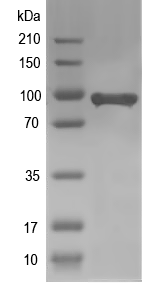Protein expression services for Kcnb1 | Potassium voltage-gated channel subfamily B member 1
Description
Voltage-gated potassium channel that mediates transmembrane potassium transport in excitable membranes, primarily in the brain, but also in the pancreas and cardiovascular system. Contributes to the regulation of the action potential (AP) repolarization, duration and frequency of repetitive AP firing in neurons, muscle cells and endocrine cells and plays a role in homeostatic attenuation of electrical excitability throughout the brain (PubMed:14684365, PubMed:19383458, PubMed:24494598). Plays also a role in the regulation of exocytosis independently of its electrical function (By similarity). Forms tetrameric potassium-selective channels through which potassium ions pass in accordance with their electrochemical gradient. The channel alternates between opened and closed conformations in response to the voltage difference across the membrane. Homotetrameric channels mediate a delayed-rectifier voltage-dependent outward potassium current that display rapid activation and slow inactivation in response to membrane depolarization (PubMed:22056818). Can form functional homotetrameric and heterotetrameric channels that contain variable proportions of KCNB2; channel properties depend on the type of alpha subunits that are part of the channel (By similarity). Can also form functional heterotetrameric channels with other alpha subunits that are non-conducting when expressed alone, such as KCNF1, KCNG1, KCNG3, KCNG4, KCNH1, KCNH2, KCNS1, KCNS2, KCNS3 and KCNV1, creating a functionally diverse range of channel complexes (By similarity). Heterotetrameric channel activity formed with KCNS3 show increased current amplitude with the threshold for action potential activation shifted towards more negative values in hypoxic-treated pulmonary artery smooth muscle cells (By similarity). Channel properties are also modulated by cytoplasmic ancillary beta subunits, such as AMIGO1, KCNE1, KCNE2 and KCNE3, slowing activation and inactivation rate of the delayed rectifier potassium channels (PubMed:22056818). In vivo, membranes probably contain a mixture of heteromeric potassium channel complexes, making it difficult to assign currents observed in intact tissues to any particular potassium channel family member. Major contributor to the delayed-rectifier voltage-gated potassium current in neurons of the central nervous system, sympathetic ganglion neurons, neuroendocrine cells, pancreatic beta cells, cardiomyocytes and smooth muscle (PubMed:10506487, PubMed:12270920, PubMed:17767909, PubMed:23161216, PubMed:24494598). Mediates the major part of the somatodendritic delayed-rectifier potassium current in hippocampal and cortical pyramidal neurons and sympathetic superior cervical ganglion (CGC) neurons that acts to slow down periods of firing, especially during high frequency stimulation (By similarity). Plays a role in the induction of long-term potentiation (LTP) of neuron excitability in the CA3 layer of the hippocampus (PubMed:24494598). Contributes to the regulation of the glucose-induced amplitude and duration of action potentials in pancreatic beta-cells, hence limiting calcium influx and insulin secretion (PubMed:12270920, PubMed:17767909, PubMed:19383458, PubMed:23161216). Plays a role in the regulation of resting membrane potential and contraction in hypoxia-treated pulmonary artery smooth muscle cells (By similarity). May contribute to the regulation of the duration of both the action potential of cardiomyocytes and the heart ventricular repolarization QT interval (PubMed:10506487, PubMed:14684365). Contributes to the pronounced pro-apoptotic potassium current surge during neuronal apoptotic cell death in response to oxidative injury (By similarity). May confer neuroprotection in response to hypoxia/ischemic insults by suppressing pyramidal neurons hyperexcitability in hippocampal and cortical regions (By similarity). Promotes trafficking of KCNG3, KCNH1 and KCNH2 to the cell surface membrane, presumably by forming heterotetrameric channels with these subunits (By similarity). Plays a role in the calcium-dependent recruitment and release of fusion-competent vesicles from the soma of neurons, neuroendocrine and glucose-induced pancreatic beta cells by binding key components of the fusion machinery in a pore-independent manner (By similarity).
Family
Belongs to the potassium channel family. B (Shab) (TC 1.A.1.2) subfamily. Kv2.1/KCNB1 sub-subfamily.
Species
Mus musculus
Length
857 amino acids
Sequence
MPAGMTKHGSRSTSSLPPEPMEIVRSKACSRRVRLNVGGLAHEVLWRTLDRLPRTRLGKLRDCNTHDSLLQVCDDYSLEDNEYFFDRHPGAFTSILNFYRTGRLHMMEEMCALSFSQELDYWGIDEIYLESCCQARYHQKKEQMNEELKREAETLREREGEEFDNTCCAEKRKKLWDLLEKPNSSVAAKILAIISIMFIVLSTIALSLNTLPELQSLDEFGQSTDNPQLAHVEAVCIAWFTMEYLLRFLSSPKKWKFFKGPLNAIDLLAILPYYVTIFLTESNKSVLQFQNVRRVVQIFRIMRILRILKLARHSTGLQSLGFTLRRSYNELGLLILFLAMGIMIFSSLVFFAEKDEDDTKFKSIPASFWWATITMTTVGYGDIYPKTLLGKIVGGLCCIAGVLVIALPIPIIVNNFSEFYKEQKRQEKAIKRREALERAKRNGSIVSMNMKDAFARSIEMMDIVVEKNGEGVAKKDKVQDNHLSPNKWKWTKRALSETSSSKSFETKEQGSPEKARSSSSPQHLNVQQLQDMYSKMAKTQSQPILNTKEMAPQSQPQEELEMGSMPSPVAPLPTRTEGVIDMRSMSSIDSFISCATDFPEATRFSHSPLASLSGKSGGSTAPEVGWRGALGASGGRLMETNPIPEASRSGFFVESPRSSMKTHNPMKLRALKVNFLEGDPTPLLPALGLYHDPLRNRGGAAAAVAGLECASLLDKPVLSPESSIYTTASARTPPRSPEKHTAIAFNFEAGVHQYIDTDTDDEGQLLYSVDSSPPKSLHGSTSPKFSLGARTEKNHFESSPLPTSPKFLRPNCVYASEGLPGKGPGAQEKCKLENHTSPDVHMLPGGGAHGSTRDQSI
Mass
95.6 kDa
Simulated SDS-PAGE
 (Note: Representative image - actual molecular weight may vary depending on tag type and expression method)
(Note: Representative image - actual molecular weight may vary depending on tag type and expression method)Safety
Upon ordering, we will perform rigorous biosecurity and export control screening to ensure that order fulfillment is consistent with all legal and regulatory guidance.
Protein synthesis service
Make Kcnb1 using our protein expression services starting at $99 + $.30/amino acid in as fast as two weeks (includes the cost of DNA synthesis)
Order Here